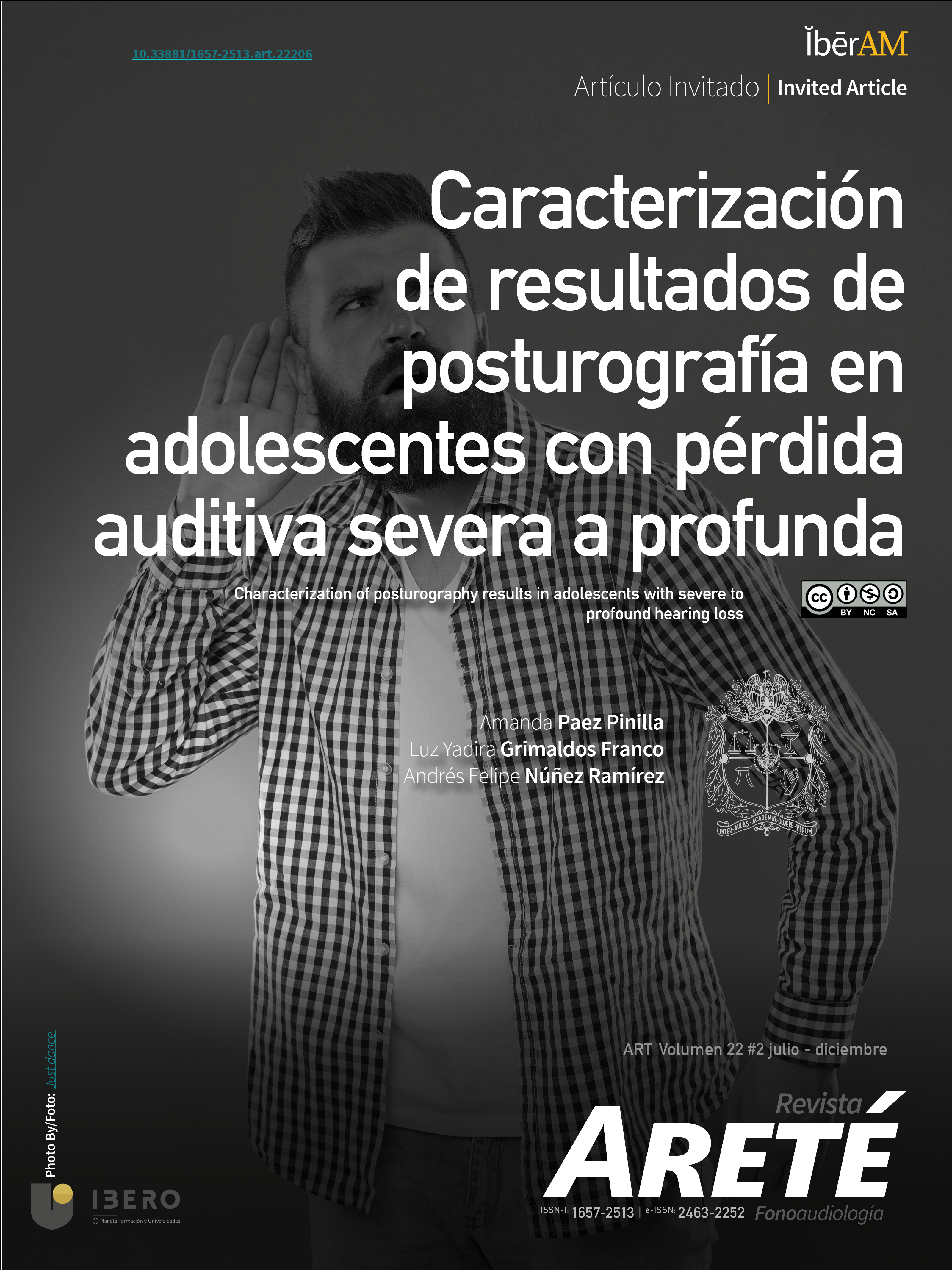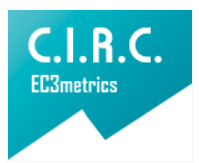Characterization of posturography results in adolescents with severe to profound hearing loss
Caracterización de resultados de posturografia en adolescentes con pérdida auditiva severa a profunda
Main Article Content
Context: Hearing loss in adolescents is accompanied by unnoticed vestibular disorders that impact motor development and influence learning. Early identification and knowledge about vestibular neuromaturation provides alternatives to improve academic performance. Objectives: to characterize the results of posturography in adolescents with severe to profound hearing loss. Method: quantitative study, with descriptive technique, searching for relationships between studied variables. Population: 38 adolescents with severe to profound sensorineural hearing loss, in groups of 12 - 15 and 16 - 19 years old. Results: older adolescents presented less oscillatory movement. With a developmental history, they showed lower performance in posturography and greater difficulties in quantitative thinking, language and communication. Discussion: neuromadurative antecedents are important for the development of balance and equilibrium. No direct relationships were recorded between posturography with low academic performance, however, it was clinically useful providing sensory, motor and vestibular performance data, for intervention. Conclusions: The results suggest indirect effect on verbal academic performance. The integration of the sensorimotor, visual, vestibular and cognitive systems is key to the development of learning skills. Maturation is an active process in the transition from adolescence to adulthood. The relationship between vestibular deficit and developmental history, such as premature birth or age of onset of walking, merits identifying risk factors of the vestibular system in early childhood. The socio-affective environment, the family and living with peers are important for academic performance.
Downloads
Publication Facts
Reviewer profiles N/A
Author statements
Indexed in
- Academic society
- Bogotá: Corporación Universitaria Iberoamericana
- Publisher
- Bogotá: Corporación Universitaria Iberoamericana
Article Details
Aedo, C., Collao, J., & Délano, P. (2016). Anatomía, fisiología y rol clínico de la corteza vestibular. Revista de otorrinolaringología y cirugía de cabeza y cuello, 76(3), 337-346. Doi: 10.4067/S0718-48162016000300014 DOI: https://doi.org/10.4067/S0718-48162016000300014
Alvarez, R & Perez, N. (2017). The limits of stability in patients with unilateral vestibulopathy. Acta Oto-Laryngologica, 137(10), 1051-1056. Doi: 10.1080/00016489.2017.1339326 DOI: https://doi.org/10.1080/00016489.2017.1339326
Bartual, J., & Pérez, N. (1998). El sistema vestibular y sus alteraciones. Recuperado de https://www.todostuslibros.com/libros/el-sistema-vestibular-y-sus-alteraciones_978-84-458-0872-6#synopsis
Bigelow, R. T., & Agrawal, Y. (2015). Vestibular involvement in cognition: Visuospatial ability, attention, executive function, and memory. Journal of Vestibular Research, 25(2), 73-89. https://doi.org/10.3233/VES-150544 DOI: https://doi.org/10.3233/VES-150544
Brandt, T., Dieterich, M., & Strupp, M. (2013). Vertigo and Dizziness. Springer London. Recuperado de http://dx.doi.org/10.1007/978-0-85729-591-0 DOI: https://doi.org/10.1007/978-0-85729-591-0
Carney, A. E., & Moeller, M. P. (1998). Treatment Efficacy. Journal of Speech, Language, and Hearing Research, 41(1), S61-S84. https://doi.org/10.1044/jslhr.4101.s61 DOI: https://doi.org/10.1044/jslhr.4101.s61
Eggermont, J., & More, J. (2011). Morphological and Functional Development of the Auditory Nervous System. En Human Auditory Development (pp. 61-105). Recuperado de http://dx.doi.org/10.1007/978-1-4614-1421-6_3 DOI: https://doi.org/10.1007/978-1-4614-1421-6_3
González, C., Caso, J., Díaz, K., & López, M. (2012). Rendimiento y factores académicos. Aportaciones de algunas evaluaciones a gran escala. Bordón. Revista De Pedagogía, 64(2), 51-68. Recuperado de https://recyt.fecyt.es/index.php/BORDON/article/view/21987/11343
Hirabayashi, S., & Iwasaki, Y. (1995). Developmental perspective of sensory organization on postural control. Brain and Development, 17(2), 111-113. Doi: 10.1016/0387-7604(95)00009-Z DOI: https://doi.org/10.1016/0387-7604(95)00009-Z
Kanekar, N., & Aruin, A. S. (2013). The Role of Clinical and Instrumented Outcome Measures in Balance Control of Individuals with Multiple Sclerosis. Multiple Sclerosis International, 2013, 190162. https://doi.org/10.1155/2013/190162 DOI: https://doi.org/10.1155/2013/190162
Katz, J., Chasin, M., English, M., Hood, J., & Tillery, L. (2015). Handbook of Clinical Audiology. Wolters Kluwer Health. Recuperado de https://books.google.com.co/books?id=QT6knQEACAAJ
Kelly, A., Liu, Z., Leonard, S., Toner, F., Adams, M., & Toner, J. (2017). Balance in children following cochlear implantation. Cochlear Implants International, 19(1), 22-25. Doi: 10.1080/14670100.2017.1379180 DOI: https://doi.org/10.1080/14670100.2017.1379180
Lee, J., Kim, C., Hong, M., Kim, S., Suh, M., Kim, M., Shim, B., Chu, H., et al (2017). Prevalence of vestibular and balance disorders in children and adolescents according to age: A multi-center study. International Journal of Pediatric Otorhinolaryngology, 94(1), 36-39. Doi:10.1016/j.ijporl.2017.01.012 DOI: https://doi.org/10.1016/j.ijporl.2017.01.012
Lopez, E. (2014). Chapter 10—Development of Fundamental Aspects of Human Auditory Perception. En R. Romand & I. Varela-Nieto (Eds.), Development of Auditory and Vestibular Systems (pp. 287-314). Recuperado de https://doi.org/10.1016/B978-0-12-408088-1.00010-5 DOI: https://doi.org/10.1016/B978-0-12-408088-1.00010-5
O’Reilly, R., Morlet, T., Grindle, C., Zwicky, E., & Field, E. (2019). Chapter 3—Development of the Vestibular System and of Balance Function: Differential Diagnosis in the Pediatric Population. En A. T. Gleason & B. W. Kesser (Eds.), Dizziness and Vertigo Across the Lifespan (pp. 31-45). United States. Recuperado de https://www.sciencedirect.com/science/article/pii/B9780323551366000034?via%3Dihub DOI: https://doi.org/10.1016/B978-0-323-55136-6.00003-4
Rine, R., & Wiener, S. (2013). Evaluation and treatment of vestibular dysfunction in children. NeuroRehabilitation, 32(3), 507-518. Doi: 10.3233/NRE-130873 DOI: https://doi.org/10.3233/NRE-130873
Sarant, J. Z., Harris, D. C., & Bennet, L. A. (2015). Academic Outcomes for School-Aged Children With Severe–Profound Hearing Loss and Early Unilateral and Bilateral Cochlear Implants. Journal of Speech, Language, and Hearing Research, 58(3), 1017-1032. https://doi.org/10.1044/2015_JSLHR-H-14-0075 DOI: https://doi.org/10.1044/2015_JSLHR-H-14-0075
Scataglini, S. (2019). Chapter 26—Posturography. En S. Scataglini & G. Paul (Eds.), DH M and Posturography (pp. 351-364). Academic Press. Recuperado de https://www.sciencedirect.com/science/article/pii/B978012816713700026X?via%3Dihub DOI: https://doi.org/10.1016/B978-0-12-816713-7.00026-X
Strupp, M., & Brandt, T. (2008). Diagnosis and treatment of vertigo and dizziness. Deutsches Arzteblatt International, 105(10), 173-180. Doi: 10.3238/arztebl.2008.0173 DOI: https://doi.org/10.3238/arztebl.2008.0173
Suárez, A., Suárez, H., & Rosales, B. (2008). Hipoacusia en niños. Archivos de Pediatría del Uruguay, 79(4), 315-319. Recuperado de http://www.scielo.edu.uy/scielo.php?script=sci_arttext&pid=S1688-12492008000400008
Suárez, H., & Ferreira, E. (2019). Rol de la información auditiva en el control motor del sistema del equilibrio en pacientes con implantes cocleares. Anales de la Facultad de Medicina, 6(2), 8-24. Doi: 10.25184/anfamed2019v6n2a10 DOI: https://doi.org/10.25184/anfamed2019v6n2a10
Suarez, H., Ferreira, E., Arocena, S., García Pintos, B., Quinteros, M., Suarez, S., & González, M. (2019). Motor and cognitive performances in pre-lingual cochlear implant adolescents, related with vestibular function and auditory input. Acta Oto-Laryngological, 139(4), 367-372. Doi: 10.1080/00016489.2018.1549750 DOI: https://doi.org/10.1080/00016489.2018.1549750
Szirmai, A. (2010). Vestibular disorders in childhood and adolescents. European Archives of Oto-Rhino-Laryngology, 267(11), 1801-1804. Doi: 10.1007/s00405-010-1283-2 DOI: https://doi.org/10.1007/s00405-010-1283-2
Taylor, J & Goodkin, H. (2011). Dizziness and Vertigo in the Adolescent. Otolaryngologic Clinics of North America, 44(2), 309-321. Doi: 10.1016/j.otc.2011.01.004 DOI: https://doi.org/10.1016/j.otc.2011.01.004
Valente, M. (2007). Maturational effects of the vestibular system: A study of rotary chair, computerized dynamic posturography, and vestibular evoked myogenic potentials with children. Journal of the American Academy of Audiology, 18(6), 461-481. Doi:10.3766/jaaa.18.6.2 DOI: https://doi.org/10.3766/jaaa.18.6.2
Whitney, S., Alghadir, H., & Anwer, S. (2016). Recent Evidence About the Effectiveness of Vestibular Rehabilitation. Current Treatment Options in Neurology, 18(3), 13. Doi:10.1007/s11940-016-0395-4 DOI: https://doi.org/10.1007/s11940-016-0395-4

















